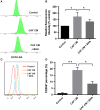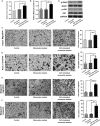Cancer-associated fibroblasts promote M2 polarization of macrophages in pancreatic ductal adenocarcinoma
- PMID: 28097809
- PMCID: PMC5313646
- DOI: 10.1002/cam4.993
Cancer-associated fibroblasts promote M2 polarization of macrophages in pancreatic ductal adenocarcinoma
Abstract
Pancreatic ductal adenocarcinoma (PDAC) is characterized by remarkable desmoplasia with infiltration of distinct cellular components. Cancer-associated fibroblasts (CAFs) has been shown to be among the most prominent cells and played a significant role in shaping the tumor microenvironment by interacting with other type of cells. Here, we aimed to investigate the effect of CAFs in modulating phenotype of tumor-associated macrophages (TAM). Under treatment of CAFs conditioned medium (CM) or direct co-culture with CAFs, monocytes exhibited enhanced expression of CD206 and CD163 compared with control group (P < 0.01). The induction of M2 polarization was mediated by increased reactive oxygen species (ROS) production in monocytes as ROS elimination abolished the effect of CAFs (P < 0.05). The supernatant analysis showed that pancreatic CAFs produced increased macrophage colony-stimulating factor (M-CSF). Upon treatment of M-CSF neutralizing antibody, the ROS generation and M2 polarization of CAFs CM-stimulated monocytes were significantly inhibited (P < 0.05). In addition, the CAFs-induced M2 macrophages significantly enhanced pancreatic tumor cell growth, migration, and invasion. Collectively, our data revealed that pancreatic CAFs were able to induce a tumor-promoting TAM phenotype partly through secreted M-CSF and enhanced ROS production in monocytes, indicating possible treatment strategies by targeting stromal cell interaction within PDAC microenvironment.
Keywords: Cancer-associated fibroblasts; Macrophage colony-stimulating factor (M-CSF); pancreatic adenocarcinoma; reactive oxygen species; tumor-associated macrophages.
© 2016 The Authors. Cancer Medicine published by John Wiley & Sons Ltd.
Figures




Similar articles
-
The pancreatic cancer secreted REG4 promotes macrophage polarization to M2 through EGFR/AKT/CREB pathway.Oncol Rep. 2016 Jan;35(1):189-96. doi: 10.3892/or.2015.4357. Epub 2015 Oct 29. Oncol Rep. 2016. PMID: 26531138
-
Stromal fibroblasts shape the myeloid phenotype in normal colon and colorectal cancer and induce CD163 and CCL2 expression in macrophages.Cancer Lett. 2021 Nov 1;520:184-200. doi: 10.1016/j.canlet.2021.07.006. Epub 2021 Jul 10. Cancer Lett. 2021. PMID: 34256095
-
Tumor-associated macrophages exhibit pro- and anti-inflammatory properties by which they impact on pancreatic tumorigenesis.Int J Cancer. 2014 Aug 15;135(4):843-61. doi: 10.1002/ijc.28736. Epub 2014 Feb 5. Int J Cancer. 2014. PMID: 24458546
-
The function of microRNA related to cancer-associated fibroblasts in pancreatic ductal adenocarcinoma.Biochem Pharmacol. 2025 Jun;236:116849. doi: 10.1016/j.bcp.2025.116849. Epub 2025 Mar 6. Biochem Pharmacol. 2025. PMID: 40056941 Review.
-
CAFs-Associated Genes (CAFGs) in Pancreatic Ductal Adenocarcinoma (PDAC) and Novel Therapeutic Strategy.Int J Mol Sci. 2024 May 30;25(11):6003. doi: 10.3390/ijms25116003. Int J Mol Sci. 2024. PMID: 38892190 Free PMC article. Review.
Cited by
-
Insights into CSF-1R Expression in the Tumor Microenvironment.Biomedicines. 2024 Oct 18;12(10):2381. doi: 10.3390/biomedicines12102381. Biomedicines. 2024. PMID: 39457693 Free PMC article. Review.
-
Prognostic biomarkers related to tumoral microenvironment in pancreatic ductal adenocarcinoma: a systematic review.Rom J Morphol Embryol. 2021 Jul-Sep;62(3):671-678. doi: 10.47162/RJME.62.3.03. Rom J Morphol Embryol. 2021. PMID: 35263394 Free PMC article.
-
PDAC, the Influencer Cancer: Cross-Talk with Tumor Microenvironment and Connected Potential Therapy Strategies.Cancers (Basel). 2023 May 26;15(11):2923. doi: 10.3390/cancers15112923. Cancers (Basel). 2023. PMID: 37296886 Free PMC article. Review.
-
Collagen Lattice Model, Populated with Heterogeneous Cancer-Associated Fibroblasts, Facilitates Advanced Reconstruction of Pancreatic Cancer Microenvironment.Int J Mol Sci. 2024 Mar 27;25(7):3740. doi: 10.3390/ijms25073740. Int J Mol Sci. 2024. PMID: 38612551 Free PMC article.
-
CAR-Macrophage Cell Therapy: A New Era of Hope for Pancreatic Cancer.Clin Cancer Res. 2025 Aug 4:10.1158/1078-0432.CCR-25-1201. doi: 10.1158/1078-0432.CCR-25-1201. Online ahead of print. Clin Cancer Res. 2025. PMID: 40757874 Free PMC article.
References
-
- Siegel, R. L. , Miller K. D., and Jemal A.. 2015. Cancer statistics, 2015. CA Cancer J. Clin. 65:5–29. - PubMed
-
- Ryan, D. P. , Hong T. S., and Bardeesy N.. 2014. Pancreatic adenocarcinoma. New England J. Med. 371:2140–2141. - PubMed
-
- Vonlaufen, A. , Phillips P. A., Xu Z., Goldstein D., R. C. Pirola , Wilson J. S., et al. 2008. Pancreatic stellate cells and pancreatic cancer cells: an unholy alliance. Cancer Res. 68:7707–7710. - PubMed
MeSH terms
Substances
LinkOut - more resources
Full Text Sources
Other Literature Sources
Medical
Research Materials

